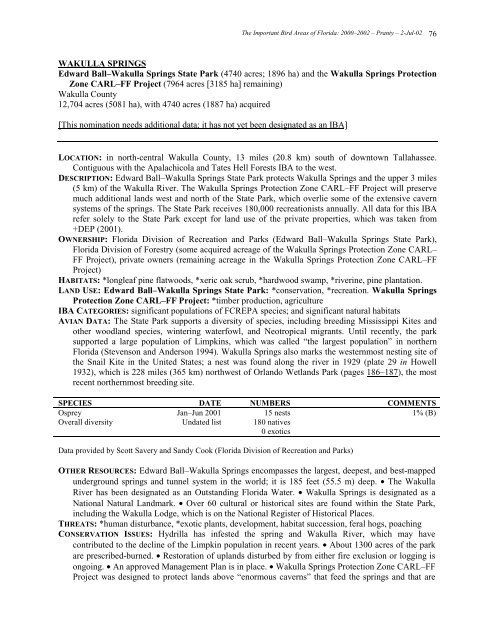The Important Bird Areas of Florida - National Audubon Society
The Important Bird Areas of Florida - National Audubon Society
The Important Bird Areas of Florida - National Audubon Society
Create successful ePaper yourself
Turn your PDF publications into a flip-book with our unique Google optimized e-Paper software.
<strong>The</strong> <strong>Important</strong> <strong>Bird</strong> <strong>Areas</strong> <strong>of</strong> <strong>Florida</strong>: 2000–2002 – Pranty – 2-Jul-02 76WAKULLA SPRINGSEdward Ball–Wakulla Springs State Park (4740 acres; 1896 ha) and the Wakulla Springs ProtectionZone CARL–FF Project (7964 acres [3185 ha] remaining)Wakulla County12,704 acres (5081 ha), with 4740 acres (1887 ha) acquired[This nomination needs additional data; it has not yet been designated as an IBA]LOCATION: in north-central Wakulla County, 13 miles (20.8 km) south <strong>of</strong> downtown Tallahassee.Contiguous with the Apalachicola and Tates Hell Forests IBA to the west.DESCRIPTION: Edward Ball–Wakulla Springs State Park protects Wakulla Springs and the upper 3 miles(5 km) <strong>of</strong> the Wakulla River. <strong>The</strong> Wakulla Springs Protection Zone CARL–FF Project will preservemuch additional lands west and north <strong>of</strong> the State Park, which overlie some <strong>of</strong> the extensive cavernsystems <strong>of</strong> the springs. <strong>The</strong> State Park receives 180,000 recreationists annually. All data for this IBArefer solely to the State Park except for land use <strong>of</strong> the private properties, which was taken from+DEP (2001).OWNERSHIP: <strong>Florida</strong> Division <strong>of</strong> Recreation and Parks (Edward Ball–Wakulla Springs State Park),<strong>Florida</strong> Division <strong>of</strong> Forestry (some acquired acreage <strong>of</strong> the Wakulla Springs Protection Zone CARL–FF Project), private owners (remaining acreage in the Wakulla Springs Protection Zone CARL–FFProject)HABITATS: *longleaf pine flatwoods, *xeric oak scrub, *hardwood swamp, *riverine, pine plantation.LAND USE: Edward Ball–Wakulla Springs State Park: *conservation, *recreation. Wakulla SpringsProtection Zone CARL–FF Project: *timber production, agricultureIBA CATEGORIES: significant populations <strong>of</strong> FCREPA species; and significant natural habitatsAVIAN DATA: <strong>The</strong> State Park supports a diversity <strong>of</strong> species, including breeding Mississippi Kites andother woodland species, wintering waterfowl, and Neotropical migrants. Until recently, the parksupported a large population <strong>of</strong> Limpkins, which was called “the largest population” in northern<strong>Florida</strong> (Stevenson and Anderson 1994). Wakulla Springs also marks the westernmost nesting site <strong>of</strong>the Snail Kite in the United States; a nest was found along the river in 1929 (plate 29 in Howell1932), which is 228 miles (365 km) northwest <strong>of</strong> Orlando Wetlands Park (pages 186–187), the mostrecent northernmost breeding site.SPECIES DATE NUMBERS COMMENTSOsprey Jan–Jun 2001 15 nests 1% (B)Overall diversity Undated list 180 natives0 exoticsData provided by Scott Savery and Sandy Cook (<strong>Florida</strong> Division <strong>of</strong> Recreation and Parks)OTHER RESOURCES: Edward Ball–Wakulla Springs encompasses the largest, deepest, and best-mappedunderground springs and tunnel system in the world; it is 185 feet (55.5 m) deep. • <strong>The</strong> WakullaRiver has been designated as an Outstanding <strong>Florida</strong> Water. • Wakulla Springs is designated as a<strong>National</strong> Natural Landmark. • Over 60 cultural or historical sites are found within the State Park,including the Wakulla Lodge, which is on the <strong>National</strong> Register <strong>of</strong> Historical Places.THREATS: *human disturbance, *exotic plants, development, habitat succession, feral hogs, poachingCONSERVATION ISSUES: Hydrilla has infested the spring and Wakulla River, which may havecontributed to the decline <strong>of</strong> the Limpkin population in recent years. • About 1300 acres <strong>of</strong> the parkare prescribed-burned. • Restoration <strong>of</strong> uplands disturbed by from either fire exclusion or logging isongoing. • An approved Management Plan is in place. • Wakulla Springs Protection Zone CARL–FFProject was designed to protect lands above “enormous caverns” that feed the springs and that are
















